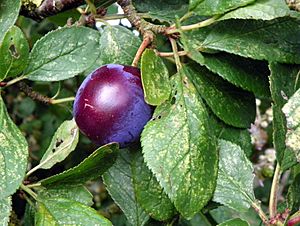Damassine facts for kids
| Type | Fruit spirit, brandy, eau-de-vie |
|---|---|
| Country of origin | |
| Region of origin | |
| Alcohol by volume | Minimum 40% |
| Proof (US) | 80° - 96° |
| Color | Clear |
| Ingredients | Red damson plum (damasson rouge) |
Damassine is a special clear drink made from red damson plums. It's a type of fruit spirit, sometimes called a fruit brandy. This unique drink is only made in the Republic and Canton of Jura in Switzerland. It follows very strict rules called AOP (Protected Designation of Origin). These rules make sure Damassine is always made in a specific way, using local ingredients.
Contents
A Look at Its Past
People have been making Damassine in the Jura region for a very long time. But no one really knows how the red damson plum first arrived there. The true story is lost to history.
Instead, there are many interesting legends. One story says knights brought the plum back from a crusade in 1129. Another legend suggests a priest named François Guenat brought seeds from Palestine in 1145. A third tale credits the Duke of Anjou, who supposedly found it in Jerusalem around 1220.
No matter how it arrived, one thing is clear: the name Damassine comes from Damascus. This is the capital city of Syria.
Protecting a Special Name
In 2002, local plum producers wanted to protect the name "Damassine." They asked for it to be recognized as an AOC (Appellation d'origine contrôlée). This would help keep the product's heritage safe.
In 2005, the Swiss Federal Office of Agriculture (FOAG) agreed. But there were some legal challenges. Finally, in 2010, the name Damassine officially received its AOP status.
This means only plum spirits made in the Jura Canton can be called Damassine. They must also follow all the special AOP rules.
How Damassine is Made
Making Damassine requires following very strict rules. All ingredients, even the water, must come from the Jura region. Also, every step of making Damassine must happen within the Jura Canton.
The Harvest
The process starts with harvesting the red damson plums. The AOP rules say plums must be collected daily, by hand. They can only be picked up after they have fallen naturally from the trees. It's against the rules to pick the fruit or shake the trees.
Sometimes, if the weather is good, plums can be collected every other day. This also applies at the very start and end of the harvest season. The harvest usually begins in mid-July and lasts until the end of September.
From Fruit to Spirit
Once the plums are harvested, they must be put into barrels very quickly. This is because the delicate fruit can spoil fast. All harvested fruit must be barreled by the day after it's picked, at the latest.
The rules also say you cannot remove the pits or grind the fruit. The plums ferment (change into alcohol) inside sealed barrels or tanks. No extra heat is used during this step.
After fermentation, the distillation process begins. This is where the liquid is heated to separate the alcohol. Distillers often add water to reduce the alcohol content. This water must also come from the protected Jura region. Damassine usually has an alcohol content between 40% and 48%.
After distillation, Damassine must be stored for at least six months in sealed containers. It cannot be sold before November 11th of the year after the harvest. In 2008, about 10,000 to 12,000 bottles of Damassine were made each year.
The Red Damson Plum
The red damson plum is also called "damasson rouge." It used to be called the "damassine plum." But after the drink got its protected status, the fruit's name was changed.
This plum is small and red, often described as having "a thousand scents." It's slightly oval and weighs about 6 to 10 grams. It measures around 2 centimeters across. The skin color isn't always the same. It can be pink to red, or even dark red where the sun hits it. The other side might be yellowish with red dots.
The size and color of the plums can change from year to year. They can also vary from tree to tree, or even on the same branch. The red damson has yellowish, juicy flesh that doesn't stick to the seed. Its skin is thick but sticks lightly to the flesh.
The fruit ripens in late July and early August. When it's fully ripe, it falls naturally from the tree. This is the best time to collect it. Picking the fruit or shaking it from the tree would make it lose its flavor and scent. About 900 red damson plums are needed to make one liter of Damassine.
Red damsons are also used to make other tasty things. These include syrups, jams, pies, chocolates, and even dried prunes.
What Does it Taste Like?
In Switzerland, Damassine is known for its unique taste and smell. This comes from the region's special limestone soil and climate.
The aromas are very complex. You can mostly smell wild plum. But there are also notes of herbs and bitter almond. The wild plum smell comes from the fruit itself. The herbal smells might come from the fact that the fruit is gathered after falling to the ground.
Other smells can be like cherries or mirabelle plums. You might also notice sweet scents like honey or dried banana. Sometimes, there are hints of spices like coriander, cloves, and a little cinnamon.


